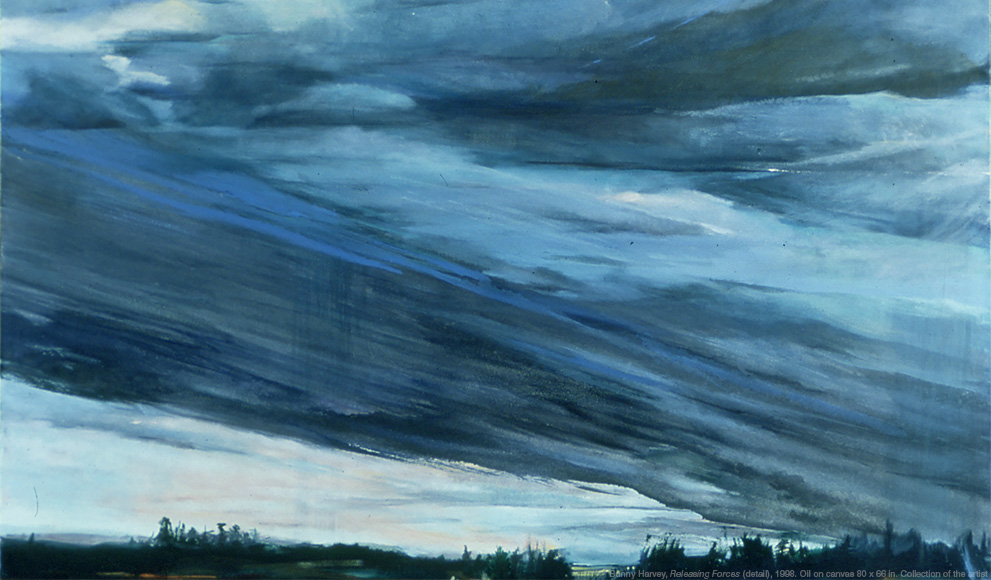Davis Museum Fall 2015 Feature Exhibition Showcases The Work Of Acclaimed Wellesley Art Professor Bunny Harvey

Art and education have always been integrated at the Davis Museum at Wellesley College, so it is with particular pleasure that the Davis presents a feature exhibition this fall that showcases the prolific works of an acclaimed Wellesley art professor. Bunny Harvey: Four Decades will be unveiled at the Davis Fall Opening Celebration, alongside four additional special exhibitions.
Wellesley and the broader community are invited to attend an opening reception tonight, September 16, 5–7:00pm, to celebrate the new season and to enjoy a first look at the following exhibitions:
Bunny Harvey: Four Decades
Bunny Harvey is the Elizabeth Christy Kopf Professor of Art at Wellesley and has been awarded the Pinanski Prize for Excellence in Teaching. She began teaching at Wellesley in 1976, the same year the Terry Dintenfass Gallery in New York presented her first one-woman exhibition. This season’s exhibition at the Davis showcases the 40 years of Harvey's work since that time, and includes drawings and both small- and large-scale paintings in the variety of themes that she has explored.
"Over the past 40 years, my work has continuously evolved," reflected Harvey. "This exhibition will showcase that evolution—from interpretations of direct observations of the landscape in Vermont, to the quiet, mysterious spaces inside an ancient Egyptian tomb, to the tracks that the smallest subatomic particle leaves in a bubble chamber. I am excited to see such a large body of my work presented in one place."
"Bunny has influenced many students and future artists," said exhibition curator Meredith Fluke, Kemper Curator of Academic Programs at the Davis. "We are honored to have the opportunity to applaud her service to the College in a show that is not only about her larger works, but that explores her works on paper and her artistic process, and that highlights her legacy as a mentor to hundreds of women."
The Krieg Cycle: Käthe Kollwitz and World War I
Following the death of her youngest son in World War I, Käthe Kollwitz's intense sorrow motivated her to seek universal pictorial forms that communicated the devastation wrought by war, in the trenches and in society at large. Over the course of eight years, the artist produced sketches, etchings, lithographs, and woodcuts, editing and distilling her imagery in preparation for what would become one of her seminal series, Krieg (War). This famous work comprises seven powerful woodcuts depicting the anguish of war and its aftermath.
Claire Whitner, Associate Curator at the Davis and curator of the Kollwitz exhibition noted that the exhibition allows viewers to not only explore Kollwitz's artistic process, but also to "acknowledge Kollwitz’s contribution to our understanding of this war and the role of women during this time. These topics should invite discussion of how Kollwitz's meditation on the cost of war resonates with current global events."
Farideh Lashai: Only a Shadow
This exhibition centers around Farideh Lashai's renowned 2012–13 multimedia installation, When I Count, There Are Only You…But When I Look, There Is Only a Shadow. For this series, Lashai meticulously recreated 80 of the 82 etchings from Francisco Goya's famous Los Desastres de la Guerra (The Disasters of War) series (1810-20, published posthumously), which articulates the cruelties of warfare as both historically specific and timelessly universal.
The exhibition's curator, Lisa Fischman, Ruth Gordon Shapiro '37 Director of the Davis, said "It is fascinating to observe Lashai's innovative use of new media in her sensitive and moving appropriation of one of Goya's best known and most challenging masterpieces."
Measuring the World: Photography, Geography and Description
"The Davis Museum has a diverse collection of photography by renowned international artists," said Measuring the World curator Ileana L. Selejan, Linda Wyatt Gruber ’66 Curatorial Fellow in Photography. "Our hope is that by bringing this group of photographs together, visitors will get a sense of how photography has helped us study history, as well as break down barriers in cultural understanding."
Through approximately 50 photographs drawn from the Museum’s extensive collection of historic to contemporary photography, this exhibition explores how the camera can function as a device for measuring the world, mediating relations between individuals and their surrounding environments.
Sight Unseen: The Davis Reveals Its Hidden Tapestries
Taking advantage of the open floor plan as the Davis prepares for the fall 2016 reinstallation of the permanent collections galleries, the curators will unroll eight of the rarely studied, large-scale tapestries from the 15th to 18th centuries from the Davis’ encyclopedic holdings. The first rotation—on view September 16 through October 25—will display three tapestries; the second rotation—on view November 3 through December 13—will exhibit five additional tapestries.
For the opening of the second rotation, the Davis will host a special event on November 3 offering viewers the opportunity to witness the unrolling of tapestries that have not been taken out of storage for decades. "Although tapestries were among the most costly and important objects created in the Early Modern period, they are often relegated to storage in American museums due to their large size and light sensitivity," said Eve Straussman-Pflanzer, Assistant Director of Curatorial Affairs/Senior Curator of Collections, and lead curator of the exhibition. "Because of the rarity of displaying these objects, we are excited to invite the public on November 3 to experience their unrolling at the same time as the Davis Museum staff."
All are invited
In addition to the opening celebration, the exhibitions will be complemented by a full schedule of events over the course of the semester, including a film series on Gender + Social Change in Weimar, gallery talks, tours, a K-12 educator workshop, and a Family Day, among others. For programming details, please visit theDavis.org and wellesley.edu/events.
The Davis Museum at Wellesley College is free and open to the public. Museum hours are 11am–5pm, Tuesdays through Sundays. (Closed Mondays, major holidays and campus recesses.) Ample complimentary parking is available.
